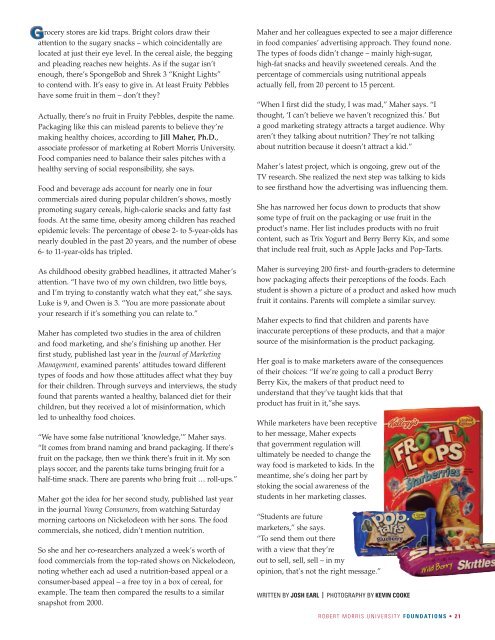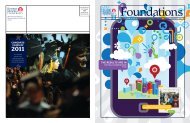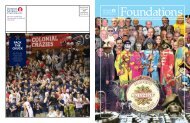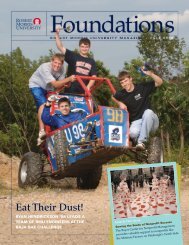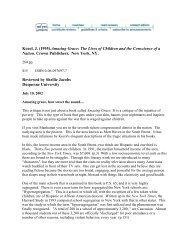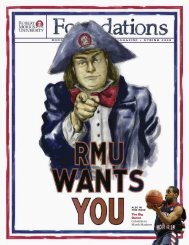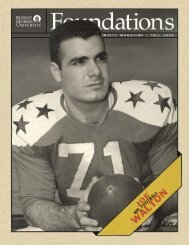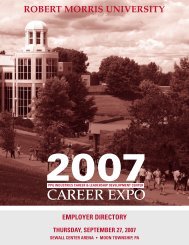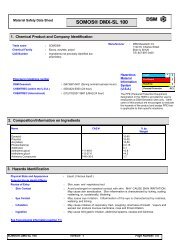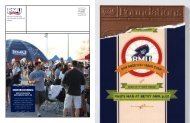Spring 2007 - Robert Morris University
Spring 2007 - Robert Morris University
Spring 2007 - Robert Morris University
- No tags were found...
Create successful ePaper yourself
Turn your PDF publications into a flip-book with our unique Google optimized e-Paper software.
ocery stores are kid traps. Bright colors draw their<br />
attention to the sugary snacks – which coincidentally are<br />
located at just their eye level. In the cereal aisle, the begging<br />
and pleading reaches new heights. As if the sugar isn’t<br />
enough, there’s SpongeBob and Shrek 3 “Knight Lights”<br />
to contend with. It’s easy to give in. At least Fruity Pebbles<br />
have some fruit in them – don’t they<br />
Actually, there’s no fruit in Fruity Pebbles, despite the name.<br />
Packaging like this can mislead parents to believe they’re<br />
making healthy choices, according to Jill Maher, Ph.D.,<br />
associate professor of marketing at <strong>Robert</strong> <strong>Morris</strong> <strong>University</strong>.<br />
Food companies need to balance their sales pitches with a<br />
healthy serving of social responsibility, she says.<br />
Food and beverage ads account for nearly one in four<br />
commercials aired during popular children’s shows, mostly<br />
promoting sugary cereals, high-calorie snacks and fatty fast<br />
foods. At the same time, obesity among children has reached<br />
epidemic levels: The percentage of obese 2- to 5-year-olds has<br />
nearly doubled in the past 20 years, and the number of obese<br />
6- to 11-year-olds has tripled.<br />
As childhood obesity grabbed headlines, it attracted Maher’s<br />
attention. “I have two of my own children, two little boys,<br />
and I’m trying to constantly watch what they eat,” she says.<br />
Luke is 9, and Owen is 3. “You are more passionate about<br />
your research if it’s something you can relate to.”<br />
Maher has completed two studies in the area of children<br />
and food marketing, and she’s finishing up another. Her<br />
first study, published last year in the Journal of Marketing<br />
Management, examined parents’ attitudes toward different<br />
types of foods and how those attitudes affect what they buy<br />
for their children. Through surveys and interviews, the study<br />
found that parents wanted a healthy, balanced diet for their<br />
children, but they received a lot of misinformation, which<br />
led to unhealthy food choices.<br />
“We have some false nutritional ‘knowledge,’” Maher says.<br />
“It comes from brand naming and brand packaging. If there’s<br />
fruit on the package, then we think there’s fruit in it. My son<br />
plays soccer, and the parents take turns bringing fruit for a<br />
half-time snack. There are parents who bring fruit … roll-ups.”<br />
Maher got the idea for her second study, published last year<br />
in the journal Young Consumers, from watching Saturday<br />
morning cartoons on Nickelodeon with her sons. The food<br />
commercials, she noticed, didn’t mention nutrition.<br />
So she and her co-researchers analyzed a week’s worth of<br />
food commercials from the top-rated shows on Nickelodeon,<br />
noting whether each ad used a nutrition-based appeal or a<br />
consumer-based appeal – a free toy in a box of cereal, for<br />
example. The team then compared the results to a similar<br />
snapshot from 2000.<br />
Maher and her colleagues expected to see a major difference<br />
in food companies’ advertising approach. They found none.<br />
The types of foods didn’t change – mainly high-sugar,<br />
high-fat snacks and heavily sweetened cereals. And the<br />
percentage of commercials using nutritional appeals<br />
actually fell, from 20 percent to 15 percent.<br />
“When I first did the study, I was mad,” Maher says. “I<br />
thought, ‘I can’t believe we haven’t recognized this.’ But<br />
a good marketing strategy attracts a target audience. Why<br />
aren’t they talking about nutrition They’re not talking<br />
about nutrition because it doesn’t attract a kid.”<br />
Maher’s latest project, which is ongoing, grew out of the<br />
TV research. She realized the next step was talking to kids<br />
to see firsthand how the advertising was influencing them.<br />
She has narrowed her focus down to products that show<br />
some type of fruit on the packaging or use fruit in the<br />
product’s name. Her list includes products with no fruit<br />
content, such as Trix Yogurt and Berry Berry Kix, and some<br />
that include real fruit, such as Apple Jacks and Pop-Tarts.<br />
Maher is surveying 200 first- and fourth-graders to determine<br />
how packaging affects their perceptions of the foods. Each<br />
student is shown a picture of a product and asked how much<br />
fruit it contains. Parents will complete a similar survey.<br />
Maher expects to find that children and parents have<br />
inaccurate perceptions of these products, and that a major<br />
source of the misinformation is the product packaging.<br />
Her goal is to make marketers aware of the consequences<br />
of their choices: “If we’re going to call a product Berry<br />
Berry Kix, the makers of that product need to<br />
understand that they’ve taught kids that that<br />
product has fruit in it,”she says.<br />
While marketers have been receptive<br />
to her message, Maher expects<br />
that government regulation will<br />
ultimately be needed to change the<br />
way food is marketed to kids. In the<br />
meantime, she’s doing her part by<br />
stoking the social awareness of the<br />
students in her marketing classes.<br />
“Students are future<br />
marketers,” she says.<br />
“To send them out there<br />
with a view that they’re<br />
out to sell, sell, sell – in my<br />
opinion, that’s not the right message.”<br />
WRITTEN BY JOSH EARL | PHOTOGRAPHY BY KEVIN COOKE<br />
ROBERT MORRIS UNIVERSITY FOUNDATIONS • 21


